Introduction: In this article, Gena Philibert-Ortega gives tips for researching funeral homes in your ancestor’s hometown that might provide helpful family history records. Gena is a genealogist and author of the book “From the Family Kitchen.”
What funeral homes serviced your ancestor’s hometown? Why is it important to know what funeral homes were located in the area your ancestor lived in?
When researching 20th century ancestors, funeral home records are a good addition to other death records (or a death certificate alternative) that can provide family names and death details, as well as how and where the person was laid to rest.
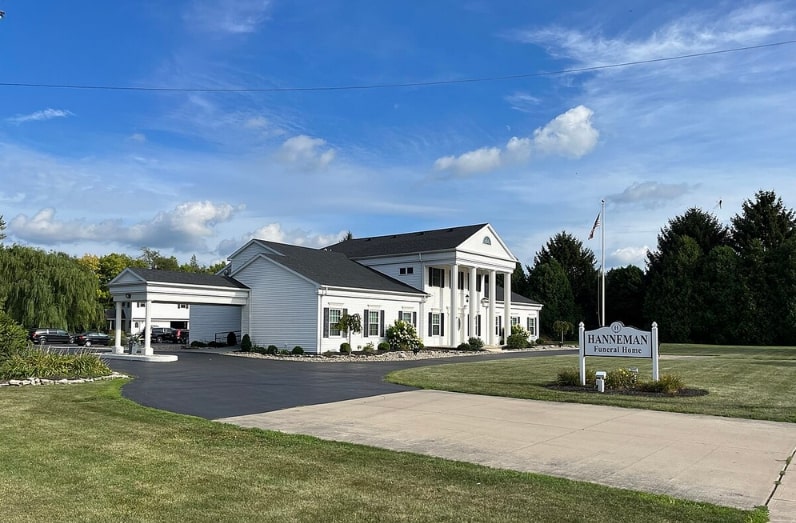
There are several ways to find the names of funeral homes, such as using a city or phone directory, or searching historical newspapers like GenealogyBank’s Historical Newspaper Archives. From advertisements to funeral notices to newspaper articles with photos, this research can provide you with ideas about where to find records or who may have been involved in your family’s preparation for a final resting place.
Here are some examples of funeral home information that can be found in old newspapers.
Articles
Different types of articles focusing on undertaking and funeral homes can be found in historical newspapers. These articles may announce a new business, a relocation, services, or information about staff. One type of article you may find (especially when a funeral home leased or purchased a new location) emphasized the new “home-like” atmosphere. In some cases, the new funeral home was actually found in a former family residence. This emphasis was important as funeral homes became the preferred place to lay out the dead and hold funerals, instead of a family home.
For example, this 1920 issue of the Fort Wayne News Sentinel praised the “modern funeral home of Getz & Cahill.” The article describing the new home of the undertaking business began with:
“The undertaking firm of Getz & Cahill are to be congratulated upon their progressiveness and achievement in securing such an elaborate home for their business.”
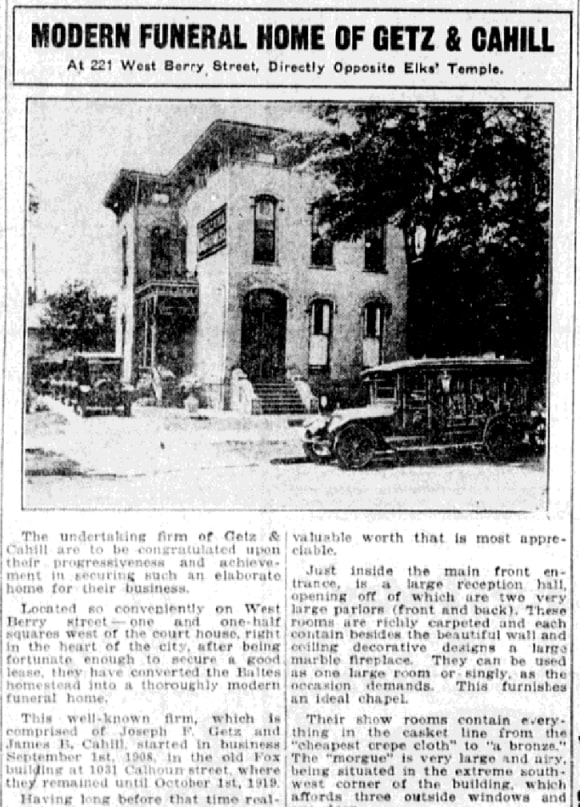
The article went on to explain that the business needed to expand from their previous location, so they secured a lease with the “Baltese heirs.” After an overall description of the house and various rooms, their new purpose was described:
The house, a large commodious two-story structure of brick and stone, has an outward appearance of quiet elegance. The interior is furnished after the same fashion. Heavy carpets are used throughout with the exception of the “morgue room,” and the decorations are rich, getting entirely away from the old idea of an undertaking establishment, nothing whatsoever savors of business and commercialism, instead there is the pure atmosphere of the home. “A quietness, a richness, a neatness, and above all a sanctity” is made possible that another location could not afford.
It’s apparent that the message readers would take away is that this is a home-like atmosphere perfect for taking care of end-of-life details.
A similar article is found in a 1926 issue of the Dallas Morning News, reporting that the Loudermilk-Sparkman Company had moved into the Col. A. H. Belo family mansion, which they leased for 50 years. The article not only described the new funeral home but gave a history of the company and the names of its employees.
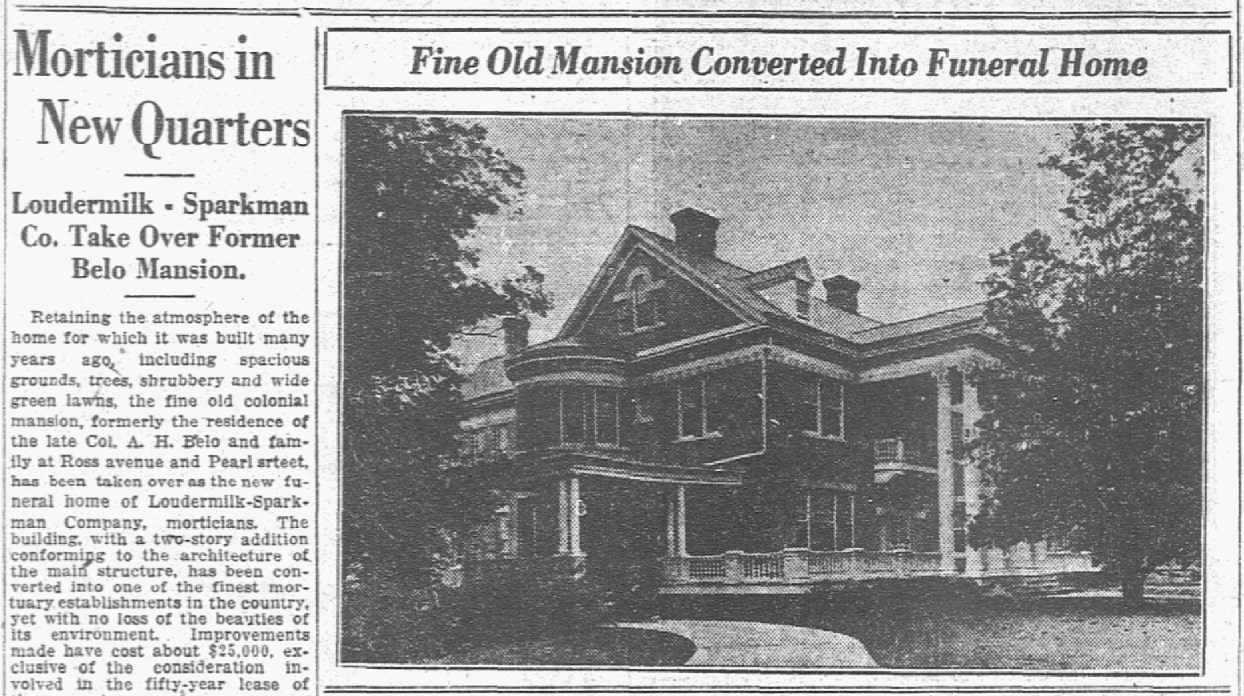
Advertisements
Newspaper advertisements for funeral homes are another way to learn what companies were serving the area where your ancestor lived. These three advertisements from a 1930 issue of the Chicago Daily News appeared near the death notices section.
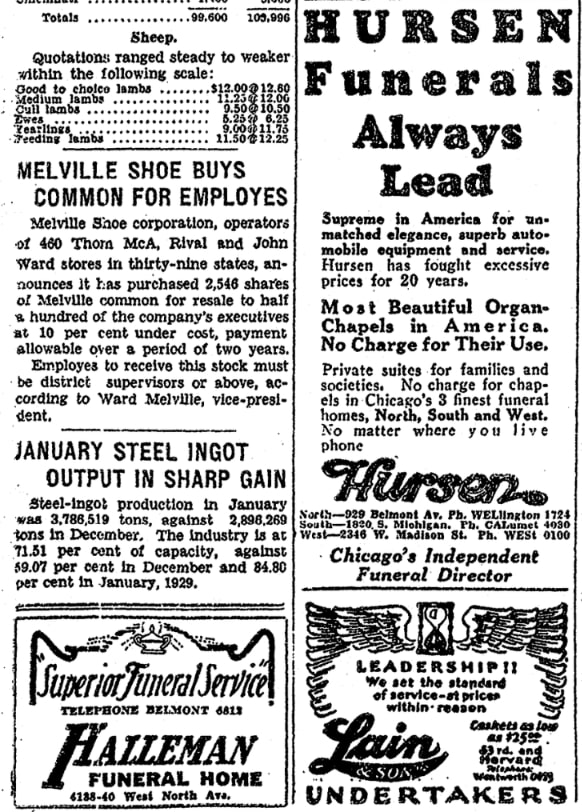
Just as in the case of the newspaper article mentioned above, sometimes an advertisement provided information about the funeral home’s staff – such as this one from a 1922 issue of the Topeka State Journal, which included photos of the staff members.
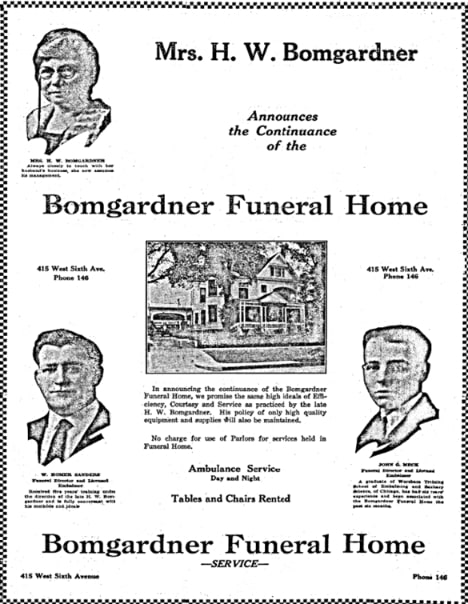
Genealogy Tip: If you know what company your ancestor worked for, don’t forget to do a separate search for the name of that company (without your ancestor’s name). That way, you may find articles or photos pertaining to your ancestor’s life that you wouldn’t have found otherwise.
Obituaries, Death, and Funeral Notices
Funeral home names might also be listed in obituaries, death notices, and funeral notices found in newspapers. This 1922 example from the Topeka State Journal titled “Deaths and Funerals” included the name of the funeral home and cemetery. The first mention of the death of James M. Riley stated his funeral was held at Bomgardner’s Funeral Home and his burial was in Dover Cemetery. Even when the obituary isn’t for your family, it might provide information helpful in finding a burial such as the name of a local funeral home or cemetery.
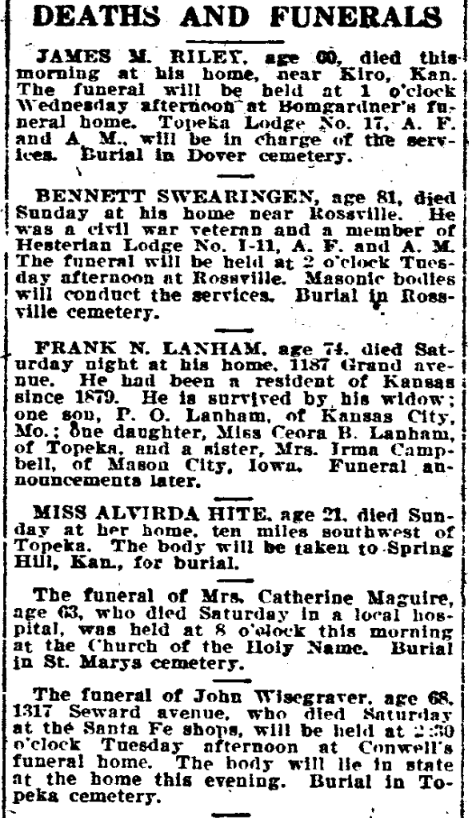
What Funeral Homes Existed?
Local historical newspapers are a great place to learn more about your ancestor’s community including what funeral homes helped families. Once you know the names of the funeral homes you can see if records survive and where they are located, giving you one more place to find information about your ancestor’s death.
Explore over 330 years of newspapers and historical records in GenealogyBank. Discover your family story! Start a 7-Day Free Trial
Note on the header image: offices of the Butterworth & Sons mortuary in Seattle, Washington, 1900. Credit: Alfred D. Bowen; Wikimedia Commons.

About five years ago I contacted the funeral home that conducted my father’s funeral. He died in 1948. The person with whom I spoke was not very helpful. In spite of the fact that I gave him my father’s full name and date of death, he said that they would have to go into the basement to look for the file for my father and that would take a lot of time. I even offered to pay for the research, but no, he wasn’t going to budge. Perhaps some funeral homes would do this, but not the one I contacted.
Michael, you are absolutely right. These are private records, and they can choose to make them available or not. Not every funeral home wants to make them available.
In your case, maybe one day, a repository will step forward and offer to digitize or store those records, making them available to researchers. Thank you for sharing your experience.
Is there any way to find their records when a funeral home has gone out of business?
Debbie, there is not one way to find those records. You might want to see if the business was sold to another funeral home. They might have the records. Also, search local archives to see if they were donated to them.
This is SO true! While researching ancestors in Fort Scott, KS, who were a pioneer family and frequently mentioned in the local paper, I began wondering why siblings who visited were only visiting their unmarried sisters — who still lived in the family home — while their mother was still alive. A visit to the local funeral home uncovered the fact that her body had been sent for burial from the state “insane” hospital in another town. Given the times, I can only guess that she may have suffered from dementia, or perhaps bi-polar disease, but it seems she was only sent there after her husband died. Maybe it was too much for her. I may never know, but at least now I know where to look for records of the final years of her life.
Denise, thank you so much for providing your example. It is possible she suffered from depression after the death of her husband. You might want to see if those hospital records are available via a nearby archive or the Kansas State Historical Society.